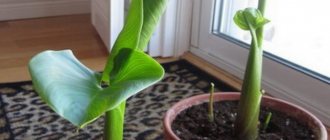The spring flower beds have faded, it’s time to plant new ones for the next season. Before this, they decide where to store tulip bulbs until subsequent planting, and how to control the conditions of their maintenance in winter, at home, in heat chambers or in the cellar.
The main thing is not to miss the right moment after flowering has completed, and to dig up the root bulbs in time. The presence of large flowers next year depends on this. And the correct division of the root affects the number of buds.
Time to dig tulip bulbs
When the tulips have already bloomed, the trunks with the seed pods are cut off, and only the leaves remain on the site. After a while they will wither and completely wither, approximately a month after the end of flowering. That's when they dig up the roots. But you cannot wait until the leaves completely disappear, otherwise the bulbs will be overripe and begin to crumble.
No one can tell you a more precise time, because there are early, mid-early, middle and late varieties. Each flowering period is different, so whether it is possible to dig will become clear by observing each species separately. If you start the procedure before the leaves wither, the characteristic brown husk will not form on the bulb, which protects it from excessive drying out and wilting. Unripe tubers cannot be stored for a long time or produce a full-fledged flower.
To extract the roots, use a pitchfork; use a shovel to injure more and often cut large tubers. If the tulips are planted in special baskets for lilies, then removing the bulbs is easier and it is almost impossible to damage them.
Possible storage problems
- high humidity, which promotes the development of rot and mold;
- high temperature conditions, at which tulips can begin to grow ahead of time;
- if the air in the room is too dry, the bulbs may dry out;
- If the tulips have sprouted, then you should think about forcing them or planting them in a box, which can later be replanted in the garden.
Why you shouldn’t leave tulip bulbs for the winter
- the seed becomes smaller. The main bulb dies after the end of flowering, but leaves children. If they are left in the ground constantly, then large and beautiful buds stop forming;
- Tulip bulbs can go deeper into the soil. And this risks the fact that young shoots will not be able to break through the layer of earth in time;
- Root crops may be damaged and rot. But annual treatment and inspection reduces the level of pests and diseases;
- lose their varietal properties. After all, weak bulbs will not produce good children capable of life.
To remove tulip tubers from the ground or not
All varieties and hybrids of tulips are divided into three groups according to the frequency of replanting:
- Annually. Parrots, lily-like, fringed, all late and Rembrandt hybrids. If these tulips are not dug up at the end of each season, they quickly lose the characteristics of the variety and degenerate.
- Once every two years. Varieties Triumph, Darwin hybrids, not varietal. During one growing season, full-fledged tubers are poorly formed, so it is not recommended to disturb them more often.
- Once every five years. Varietal tulips of Foster, Greig, Kaufman. These are low-growing plants, they are used in the design of paths. Over a five-year period, they do not degenerate and give birth to a small number of children.
Unique storage of bulbs in a cellar or basement
If there are special premises such as a basement or cellar, then a natural question arises - how to store tulips here without spoiling. Creating conditions for saving flower tubers:
- Prepare the soil. The base should consist of special garden soil, peat and vermiculite.
- Warm the soil in a water bath for half an hour to completely kill pathogenic bacteria and microorganisms.
- Plant tulip bulbs in prepared soil. The bulbs will eventually take root in the soil.
- Place the boxes with planted tubers on shelves so that rodents cannot reach them.
You need to monitor the temperature in the room - it should not be lower than 17, but not exceed 24 degrees. During such storage, the planting cannot be watered or sprayed.
Preparing bulbs for storage
Stages of preparing seed for storage:
- Dig up tulip bulbs in dry weather. The soil should be relatively moist, but not wet. Therefore, if there are other flowers nearby in the flowerbed that continue to be watered, you should stop watering for a couple of days.
- The roots are removed from the ground annually, at least once every two years, the size of the future flower depends on this. If this procedure is neglected, the bulbs go deep into the ground and gradually degenerate. Plus, when the tubers are removed, it is easier to thoroughly dig up the area and add the necessary fertilizing and fertilizers to increase soil fertility.
- The bulbs are dug up and, without removing surface scales and adhering soil, they are placed in perforated paper boxes or wicker baskets for a week.
- The container with seed material is placed on the veranda, under a canopy or in any ventilated room. The main rule: no direct sunlight! When it gets in, it leaves burns on the tender roots, which then dry out or lead to rot. There is no point in using damaged bulbs; they will not bloom.
- After a week, the tubers are cleaned of clods of soil, old scales, rotten or dry parts. Separate mature roots from children. Wash and sort by size. Treated with a fungicide to prevent the growth of bacteria on the surface.
On a note!
If multi-colored tulips grow in a flowerbed, tie a thread matching the color of the bud onto the stem. Then, when digging up and storing the tubers, it will be easier to sort them. And when planting, you will be able to compose harmonious compositions in advance.
Where are the bulbs stored?
Before digging up and storing the bulbs, you need to decide where exactly to store them. There will be no trouble with those bulbs that will be planted in the fall. They are stored at a temperature of plus twenty-five degrees, poured into a box. They don't need special conditions.
If the bulbs need to be planted in the spring, then it is necessary to create certain conditions for them. The bulbs need a dry, ventilated room with an air temperature of fifteen degrees. In this case, the temperature must be lowered gradually, simulating natural conditions.
You can store the bulbs on the bottom shelf of the refrigerator, but after such storage not all varieties of tulips bloom. Most grow only leaves. A cold pantry, warm balcony, basement or cellar are good places to store bulbs until spring.
The ideal option is a dry underground floor, the temperature in which does not fall below ten degrees Celsius. True, this option sounds like a mockery for most summer residents living in apartment buildings.
If finances allow, you can purchase a thermal chamber for storing flower bulbs. After determining the storage location, you can begin digging up the bulbs and preparing them for winter storage.
Drying rules
Flower bulbs should be dried in well-ventilated areas. Gazebos, canopies, dry basements, verandas, attics, and balconies are suitable for this purpose. The main thing is to make sure that the temperature is maintained, not higher than 25 degrees.
Direct sunlight is harmful to rhizomes. Only diffused light, semi-darkness or shaded conditions are suitable for harmless drying.
Conclusion
Which option to choose is up to the gardener to decide, but it’s worth remembering the basic storage rules:
- keep tulip bulbs at a temperature not lower than 17°, but not higher than 25°C;
- air humidity should not exceed 70%;
- do not use cardboard boxes;
- For storage, use a dry and well-ventilated area.
- If you store the bulbs correctly, in the spring they will delight you with bright flowers and large buds.
Currently reading:
- How to grow Chinese cabbage in open ground
- Using hydrogel in open ground for plants
- Planting to decorate the site with three types of coniferous trees
- Increased potato yield using Dutch technology
Share the news on social networks
About the author: Victoria Semyonovna Nakhodkina
Leading researcher at the laboratory of vegetable and berry crops, Yakut Scientific Research Institute of Agriculture, Siberian Branch of the Russian Academy of Agricultural Sciences, Republic of Sakha (Yakutia).
What to do with the bulbs after drying
After final drying, the seed is prepared for sorting and storage:
- Each tuber is inspected, dry, easily separated scales are removed.
- The above-ground part is carefully cut with pruning shears or small garden shears, but not too deep, so as not to damage the root.
- Disinfect for 30 minutes in a pale pink manganese solution and dry.
How to prepare bulbs for spring planting
Tulips preserved over the winter should be prepared for this process before planting. To do this, follow a series of simple steps:
- cleansing of dense peel;
- inspection (detection of damage);
- soaking before planting.
Important! Store-bought bulbs can be hardened off before planting by placing them in the refrigerator overnight.
The first event helps to conduct an inspection and will contribute to better nutrition of the bulb during growth. The second is needed to cull unsuitable planting material. The third is very important: for its implementation, a solution of potassium permanganate is used (such as when processing in the fall). The shoots should be soaked immediately before planting for half an hour.
Quite simple activities for collecting, sorting and drying tulips are very useful. Further storage is also not difficult - you need to observe the temperature regime, the humidity level of the place where the planting material is stored and the basic rules necessary for preserving the bulbs in winter. By fulfilling all the simple requirements for wintering tulips, gardeners get an excellent result as a result of their actions - beautiful bulbous plantings in the garden.
Storage conditions
There are two storage options:
- those that will be planted in the fall;
- those that will be planted in the spring.
At first, the procedure for both bulbs will be the same. When storing tulip roots in summer, temperature and humidity levels are taken into account. In the first month after being removed from the soil, the tubers need temperatures no higher than 23-25 degrees. Acceptable humidity level is 60-70%.
On a note!
When planting tulips in the fall at different times, you can achieve interesting results. Thus, by placing bulbs in the ground at intervals of one and then two weeks, the period of bright flowering of plants of the same variety is extended. The buds bloom at the same interval that was maintained between autumn plantings.
How to store tulip bulbs before planting:
- on the floor in cardboard boxes, wooden baskets, on wooden shelves;
- hanging from the ceiling - in mesh string bags, in nylon tights.
With any of the methods, the bulbs are laid out in one, maximum two layers, ensuring air access and good ventilation.
In the summer storage of tulip bulbs, future organs of the plant are laid: stem, leaves, peduncle. If the temperature is above 25 degrees, the buds will not form. At low humidity the roots will dry out, at high humidity they will rot.
Tulip tubers larger than 3 cm in size, intended for planting in spring, are placed for long-term storage. Some gardeners recommend throwing away children smaller than 1 cm, since the period of their first flowering will last for one or two years. But if it’s a pity to throw them away, then they set aside an area where they don’t plan to dig the soil for two years. There they will produce a modest harvest next season or the year after.
How to store it correctly
Every experienced gardener has plenty of ways to properly store bulbs. Usually, over time, a person chooses the one that suits him best. Methods for storing bulbs. Bulbs are stored in:
- sand;
- sawdust;
- peat;
- agrovermiculite.
Important! You cannot use a cardboard box as a storage box. The cardboard may become wet, moisture will be absorbed into the filler and the bulbs will become moldy.
Sand
The bulbs are laid out in one row and covered with dry sand. The disadvantages are the heavy sand, which makes it impossible to store the bulbs in several rows. Premature germination of bulbs is possible.
Sawdust
A very good option for storing tulip bulbs. Sawdust will prevent the tubers from losing too much moisture or absorbing it from the air. Sawdust itself is not very hygroscopic, but has good heat-insulating properties.
When choosing sawdust, it should be taken into account that the larger the sawdust, the less hygroscopic they are. You will have to choose the dispersion of sawdust yourself, based on the existing storage conditions.
For example, if boxes are stored outdoors and snow gets on the sawdust, during a thaw large sawdust will let water through to the very bottom, while small sawdust will absorb moisture on the top layer.
Of the minuses: too small sawdust generates a lot of dust, which has a harmful effect on the human respiratory tract.
Peat
Also a good drawer filler. Here you need to make sure that the peat is dry. The bulbs will perceive wet peat as a substrate for germination. However, it is not a fact that the bulbs will even be able to germinate.
Peat is often acidic, while tulips prefer neutral or alkaline soil. This is especially true for high-moor peat. Lowland peat often has an acidity between 6.4 and 7.0, but lowland peat is already a substrate for germination.
Important! Do not use sphagnum moss to store bulbs. This is a very hygroscopic material that will draw all the moisture from the tubers.
Agrovermiculite
A mineral used to loosen soil mixtures and as a filler when storing plant roots. It is good because it can absorb excess moisture, gradually releasing it if necessary. Thus, tulip bulbs stored in the mineral will not become moldy due to excessive humidity, but will not dry out due to too dry air. The disadvantage is the same as that of sawdust. Vermiculite dust is harmful to the respiratory tract.
The general principle of storing tubers in boxes with fillers: pour a cushion of filler, lay out the bulbs, cover with a thick layer (from eight to thirteen centimeters) of filler, repeat the cycle. You should be more careful with sand.
What kind of place should be suitable for storing bulbs?
During long-term storage of tulip bulbs, the following indicators are monitored:
- Stable temperature conditions in winter. Unlike summer storage, where flower organs are laid, this is a dormant period when the plant needs +10 or +15 degrees.
- Constant humidity in the range of 60-70%.
- Air flow and good ventilation.
- Lack of access for rodents, for whom bulbs are a favorite treat.
On a note!
If you cannot avoid the visits of mice and rats in the place where the tulip bulbs will be stored, then tie the nets to the ceiling. Rodents will not be able to get there, but the necessary conditions will be met.
Sorting after processing
Sorting after digging consists of dividing the planting material as follows:
- by size - large onions should be stored separately from small ones;
- by variety - they can be signed and labeled, which is convenient when planting to form a flowerbed pattern.
We recommend finding out whether you need to dig up tulips after flowering every year.
And after sorting, you should pay attention to the following points:
- the presence of covering scales and remains of stems;
- non-standard forms;
- damage;
- diseases.
All excess is removed, leaving only whole and healthy planting material that must be preserved. It is large, high-quality specimens that will bloom well and delight the gardener.
Storage containers
For winter storage, use wicker baskets, plastic or wooden boxes, and wooden shelves.
To absorb excess moisture, wood shavings are poured into containers with tulip tubers. For the same purpose, wrap each spine with newspaper or wrapping paper. This method will eliminate contact with neighboring bulbs and prevent the rapid proliferation of diseases and fungi.
It is not recommended to use glass, polyethylene and plastic containers for storing planting material. The environment created in such a container is detrimental to the future plant.
Choosing the best time to land
Choosing the right time for planting is no less important than ensuring proper storage of planting material. If you delay and plant too late, the bulbs may not have time to take root and then there is a chance that they will die in the winter.
If you plant it too early, the tulip will begin to grow, the sprout will appear on the surface of the ground, and at this moment frosts will most likely strike. Even if the sprouted bulb does not die, it most likely will not be able to bloom next year, producing only foliage.
At the time of planting, the soil temperature should be +7...+10 degrees, and the air temperature +3...+6 degrees; it will take about three weeks for the tulip bulbs to fully root.
Our country is large and planting dates may vary depending on the climate. In the central zone, tulips are planted in the first half of October, in Siberia this can be done as early as the end of August (if the weather is warm, then it can be done in September). In the Urals, planting should be carried out in the second half of September (you can capture the first days of October). And in the southern regions they plan to plant tulips at the end of October or even at the beginning of November.
Prepare the soil thoroughly before planting. Remember that all bulbous plants do not tolerate stagnant liquid, so you need to make sure that the soil is not too dense and provide the necessary drainage (if necessary, remove the layer of soil and fill in expanded clay). If your site is dominated by clay, then add sand or peat, this will make the soil more breathable and nutritious. If the soil, on the contrary, is sandy, then compost should be added to it, as well as enriched with mineral fertilizers.
After the soil for tulips is prepared, mark furrows or holes for the bulbs and water them with a solution of potassium permanganate (for disinfection). The planting depth of a tulip is usually equal to triple the height of the bulb; the distance between the bulbs should be at least 12 cm. In loose soil, the bulbs can be buried a little more, but in dense and heavy soil, on the contrary, less. Small onions, from which we do not yet expect to bloom, can be planted closer to each other.
Before planting, it is recommended to dust the bulbs with ash; this will provide both additional fertilizer and protection from fungal infections. When lowering the bulb into the ground, apply a little pressure to prevent the formation of an “air pocket”. Then fill the holes or furrows with soil and level the surface. If there is no rain in the next week, be sure to water the tulip bed so that the root system can fully develop.
There is no clear opinion whether it is necessary to cover tulips during frosts or whether snow cover will be enough for them. But since it requires very little effort and will increase the chances of your plants having a favorable winter, I strongly recommend that you mulch the soil around the bulbs. You can use straw, dry leaves, spruce branches or fallen pine needles for this. But do not forget to remove the mulch in a timely manner in the spring so that the tulips have access to sunlight.
Please note that agricultural stores and garden centers sell special baskets and containers for growing bulbous flowers (not only tulips, but also daffodils, crocuses, hyacinths). This is very convenient, in this case the bulbs are placed in a basket with fertile soil (there are holes in the bottom of the basket or container), and only then the basket is placed in a recess in the flowerbed
This method allows you not to lose the bulbs, ensures their safety when removed from the ground, and also protects them from damage by mice.
Existing methods for storing bulbs
You should find out how to store tulip bulbs in winter at home and in basements in advance. To create the right microclimate and allocate suitable space.
Apartment
You can store the roots in your apartment until spring, subject to a number of conditions:
- The container with tubers should be deprived of light. In nature, in winter they are in the ground, breaking the rules is harmful to the plant.
- Room temperature up to +15 degrees. Finding such a place in an apartment is problematic. Therefore, common corridors, specially equipped storage rooms or an insulated balcony are better suited.
- Humidity is 60-70%; if there is no hygrometer, this can be determined by the appearance of the bulb. The surface is smooth, shiny, sufficient density, not wrinkled, not flaccid - this means that everything is in order.
Cellar
When storing tulip roots in the cellar, pay close attention to the level of humidity. Solid earthen cellars with insufficient ventilation are not suitable. The room should not be damp.
Before putting it into the cellar, check for pest passages in the walls. If rodents are frequent guests, then drive several hooks into the ceiling and store the planting material in a suspended state.
Fridge
It is possible to store tulip bulbs in the refrigerator if there are few of them and there are no other options. But this is not the best way to preserve the plant's vegetation.
The roots are placed in the “warmest” place of the refrigerator, intended for storing vegetables and herbs. To prevent mold, wrap each onion in napkins or a paper towel. As the paper gets wet, it is replaced with dry paper.
Thermal chamber
The ideal place to store tulip planting material is thermal chambers. But not every amateur summer resident can afford their cost. Those who grow flowers for sale or are engaged in breeding will sooner or later have to fork out for such a device.
In such chambers, the temperature regime is automatically set and the humidity level is set. And for a long time, and in this case almost six months, the conditions remain unchanged.
On a note!
Thermal chambers are sometimes called homemade boxes where the same storage conditions are constantly maintained. Temperature and humidity sensors are built into or placed in them. Keep them on an insulated balcony or in a cellar.
How to preserve tulip tubers when problems arise
During long-term storage, the bulbs may rot or dry out, so they need to be inspected weekly. Sometimes the bulbs become moldy. In case of severe molding, the bulbs are removed from the total mass and discarded. Mold is a fungus and, like any fungus, we can only see its reproductive organs.
The real body of the fungus is much larger (in relation to edible mushrooms, this body is called the mycelium) and penetrates very deeply into the nutrient substrate. Therefore, a very moldy tulip tuber is already affected by mold inside.
If the mold is mild, you can try to save the bulb by wiping it from mold and disinfecting it. Disinfection is carried out with a solution of foundationazole or potassium permanganate with further drying of the bulb. Instead of solutions, you can sprinkle with crushed coal. Such bulbs should be kept separately from the rest of the planting material.
Attention! To avoid molding of the bulbs, they must be thoroughly dried before storing and not stored in places with high humidity.
The best solution when discovering a rotten onion is to remove it from the storage container before it contaminates the rest of the material and destroy it.
But if this particular bulb is dear to the gardener (a rare variety and a small number of specimens), then you can try to preserve it, observing certain conditions.
Putrefactive spots are cut out with a disinfected sharp knife (preferably a scalpel) until the healthy body of the tuber is removed. The sections are rubbed with charcoal, coated with brilliant green or powdered with sulfur. Store bulbs damaged by putrefactive bacteria separately.
If your bulbs rebelled and decided to germinate before the time you set for them, then there is only one way out: use them for forcing or plant them in a basket, which you will bury in the garden at the first opportunity. If the weather is already permitting, then it is better to immediately plant the bulbs in their permanent place in the flowerbed.
It is easy to see that the problem of “how to preserve tulip bulbs until spring in a private household or at home” is generally solvable, but you need to get used to it. With experience and skill, preparing bulbs for storage can even become a way of relaxation.
Early forcing and wet germination as storage methods
When it is not possible to create suitable conditions, for example, the basement is damp, and it is impossible to correct this in a short time, then early forcing or wet germination is suitable. These methods
Early forcing
Tulip tubers are placed in flower pots or special trays with prepared soil; garden soil is also suitable. The containers are left on the veranda or balcony until the first frost. When temperatures drop below zero, the trays are moved to the cellar or subfloor, where they will remain until spring. Plastic bags are placed on top of the trays. Once every two weeks the soil is shed with water. Periodically remove the polyethylene for ventilation.
In the spring, when the first shoots appear, the tulips are stored in the air, and after a while they are planted in open ground along with a lump of earth. With this method, grown plants bloom earlier.
Wet germination
Plastic boxes or containers are suitable for wet germination. Sawdust and peat are poured into the bottom, moistened, and the tubers are placed bottom down. Sprinkle the same sawdust or other light substrate on top. Containers are stored in the basement.
Tulips germinated in this way bloom simultaneously with those planted in the fall.
When to dig up bulbs
On the one hand, tulip bulbs should not be dug up too early. They should gain size and nutrients for next year and form a flower bud that will begin to grow in the spring.
On the other hand, you should not keep the bulb in the ground for too long. After the leaves have completely dried, it will be difficult to find a place to plant tulips. The bulbous nest will have time to fall apart and it will be very difficult to collect all the bulbs. Some may not be noticed. Bulbs can become diseased by becoming infected with pathogenic bacteria from dead leaves that have begun to rot.
Digging of bulbs in the central zone begins at the end of June. Late varieties are dug up later. But in the southern regions the bulbs must be dug up earlier, in the northern regions later.
In order not to rack your brains, you can use a reliable sign: the bulbs are dug up when the first two leaves are already completely yellow, and the end of the peduncle can be wrapped around your finger. That is why after flowering only the seed capsule should be removed.
Important! You should not remove tulip leaves immediately after flowering, as they continue to nourish future planting material.
By this time, the bulbs are already ripening and covered with scales. Digging up tulips with a bayonet shovel. The shovel must be driven deeper into the ground than the tulips were planted, since the mother bulb, going deeper into the ground, pushes the young bulbs closer to the surface.
Drying faded tulips in the garden are also not beautiful. You don’t have to wait until they ripen on the spot, but dig them up with a clod of earth and place them, for example, in suitable boxes for ripening. If you planted tulips in baskets, then removing them from the flowerbed becomes much easier.
Attention! Bulbs dug up ahead of time are poorly stored, have a lower germination rate, and are susceptible to diseases and mechanical damage. You should also not delay it to avoid the risk of infection.
Regular checking of seed
Primary processing before storage is often not enough. All bulbs must be periodically turned over and inspected for the appearance of new spots and rottenness. Damaged roots are immediately removed, and those adjacent to them are wiped with a clean cloth and placed in a separate box to avoid further spread of bacteria.
Caring for tulips
Caring for flowers directly depends on weather conditions. During dry autumn, the place where the bulbs are planted is watered abundantly. Water should saturate the soil to at least 30 cm. After this, the soil should be mulched with peat. The height of the peat layer should not exceed 3 cm. To improve the development of the root system, flowers can be fertilized. This is best done in mid-October and ammonium nitrate: 15 grams per square meter of soil.
During frosts, the planting site is covered with spruce branches. This will protect the bulbs from rodents and save them from freezing. With the onset of spring, spruce branches are removed. In spring, tulips need to be fed with nitrogen fertilizer (50 grams x per 1 m2).
During growth, the plant needs several abundant waterings. Make sure that the soil is wet to the full extent of the tulip roots. Estimate that you should use approximately 40 liters of water per square meter per watering. Tulips for a bouquet are cut with only one, or maximum two, leaves, otherwise you will not collect good bulbs in the fall. Be sure to decapitate (cut off faded flowers).
To properly preserve the bulbs, follow these steps sequentially:
- Bulb heads removed from the ground must be carefully sorted immediately. Good ones should be put aside; those damaged by pests or diseases should be thrown away.
- Carefully place the bulbs in boxes or on a tray for ventilation. Do not place the plants tightly, try not to let them touch each other.
- Tulips should be left in the fresh air for several days. Do not expose the bulbs to direct sunlight, as this will harm them.
- After drying, remove the bulbs until next season.
Soil care
Good soil should have the following properties:
- sufficient moisture capacity;
- looseness;
- air capacity.
You can cultivate the soil using various fertilizing and fertilizers. You can buy them at any gardening store. Just remember that you cannot radically fertilize the soil if there are already plants in it. Choose a time when the soil is dormant and apply your choice of organic or inorganic fertilizer.
Temperature
Correctly chosen temperature is the key to successful forcing of plants, storing their bulbs and flowering.
The cold storage time for bulbs ranges from 3 to 7 months. At this time, physical processes occur that allow the flowering shoot to develop. If you shorten the cooling period, the flowers will grow with very short stems.
After the cold period, the bulbous heads are stored in a well-ventilated area. It is better to maintain the air temperature in the region of 15 - 17 degrees, air humidity should be 60-70 percent.
How to fertilize and feed
You can fertilize the soil with commercial compounds, purchasing them at any gardening center or store. Remember that radical fertilizing should be applied only to pre-moistened soil to avoid burns to the plant root system.
After applying dry fertilizer, it is necessary to water the post thoroughly. Water will help deliver fertilizer to the roots faster. It is good to fertilize with nitrogen, potassium and phosphorus during the appearance of buds. The proportion of fertilizer is 1/2/2. This will not only help strengthen the root system, but will also have a beneficial effect on the speed of growth of tulips.
Diseases and pests
The variegation virus is the biggest threat to flowers. The disease appears in the form of spots and stripes on the leaves and petals of the plant. Infected tulips cannot be treated; they will have to be thrown out, along with the soil in which it grew. The excavated area should be generously watered with manganese solution.
Fungal August disease is also considered a common disease. The disease manifests itself in the form of a bent stem, striped flowers and leaves dark spots on the bulb. It is better to remove the diseased plant, fill the hole with manganese solution and cover it with ash.
To prevent diseases, after digging up the bulbs, plant this place with marigolds, calendula or mustard. This simple method gives unmatched results.
The main plant pests include mole crickets, onion root mites, snails, and rodents. Do not forget to treat the bulbous heads with a manganese solution before planting. And don’t be lazy to inspect the flowers every day, collecting insects from them.
Practical advice for pest control. Dig a glass jar into the ground, filling it three-quarters full with water. Once in the jar, the insect will not be able to get out on its own and will die.
Possible storage problems and their solutions
If the necessary storage conditions are violated, the tulip tubers will show this.
If the bulbs become wrinkled and soft, the plants are signaling an insufficient level of humidity. Place a wide container of water close to the container where the roots are stored. As it evaporates, add liquid.
Another “resuscitation” option is to purchase a household air humidifier with a humidity level sensor. When the set value is reached, the device turns off. The main thing is not to forget to fill the container with water.
On a note!
If the tulip bulbs are wrinkled, do not rush to throw them away immediately. Try raising the humidity in the room where the planting material is stored. If the efforts are effective, the roots will regain their former elasticity.
When the room is too humid, rot and sores begin to develop on the surface of the tubers. Drops of water appear on the skin - a signal that the room urgently needs to be dried. Household electric heaters will help.
With diseased bulbs proceed as follows:
- Those that are completely or half rotten are destroyed.
- If the root is damaged up to 1/3, the rotten part is cut off. The cut site is treated with green diamond. These seeds are subsequently stored separately from healthy bulbs.
- Suspicious: soft or slippery roots are wiped with a clean, dry cloth and also placed in another container.
How to store tulip bulbs until spring
Store the bulbs in a dry place. The air humidity in the storage facility should not exceed seventy percent. The temperature must be reduced gradually. In August it should be twenty-one degrees, in September it should reach seventeen.
Later the temperature drops to fifteen. This is the best temperature for tulip bulbs, but such conditions for preparing tubers for long-term storage and their further storage are difficult to achieve for an ordinary city resident.
Attention! Do not cover the bulbs to retain heat.
The room must be ventilated. The bulbs themselves, giving the impression of being dormant, are preparing for the coming spring. Even with very slow vital activity, they emit ethylene, which has a harmful effect on planting material if it does not have the opportunity to evaporate. That is why a ventilated room is necessary.
Treatment after storage
Before planting, dry brown scales are removed from the surface. Bulbous plants are re-treated with a fungicide and a weak solution of potassium permanganate. The roots are kept in potassium permanganate for about half an hour. Even if the storage conditions were good, this procedure will protect the tubers from exposure to microorganisms living in the soil. And friendly, lush flowering in the flowerbed will be a reward for the efforts invested.
It is advisable to carry out repeated treatment both during autumn planting in the ground and during spring.
If you follow all the rules for digging, storing tulip bulbs, proper processing and planting, abundant flowering in the spring will be ensured. Flowerbeds of country houses and garden plots will delight you with friendly and large buds.
How do you like the article?
How to Preserve Tulip Bulbs in Winter
After the bulbs are cleared of soil, scales and dried roots, and the fused nucleoli are separated, it is necessary to carry out culling, which consists of screening out weak, diseased or damaged specimens. After selecting suitable bulbs, it is necessary to place them for drying in a dark, ventilated area and limit the access of insects to the tubers. If some bulbs cause mixed impressions regarding suitability, they are placed separately. It is worth remembering that only mature plants that have reached at least 3 years of age can survive wintering, so experienced gardeners strongly recommend returning the tubers back to the ground in the fall, without leaving them for winter storage.
Features of growing tulips
To admire the luxurious flowers of tulips every year, after flowering, the bulbs must be dug up, sorted and treated every year (or at least every other year). Otherwise, over time, they are affected by various diseases, pests appear in the beds and the plants weaken and may die. In addition, replacement bulbs tend to bury themselves deeper into the ground every year and, after a few years, removing them becomes problematic. It has been noticed that if you grow tulips in one bed for a number of years without digging them up, their varietal properties are lost over time.
Therefore, in order to preserve these beautiful flowers in the garden, at the end of June and beginning of July (when the leaves begin to wither), the ripe bulbs should be dug up, sorted by size and stored until autumn. They are usually planted in late autumn before the onset of persistent cold weather. For about three or four months, planting material must be properly stored at home.
Tulips feel great in the garden beds in winter. In case there is not enough snow, it is better to cover the plantings with tops, branches or straw.











